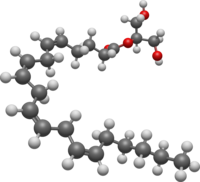
Photo from wikipedia
Extensive rodent literature suggests that the endocannabinoid (eCB) system present in the nucleus accumbens (NAc) modulates dopamine (DA) release in this area. However, expression patterns of the cannabinoid receptor type… Click to show full abstract
Extensive rodent literature suggests that the endocannabinoid (eCB) system present in the nucleus accumbens (NAc) modulates dopamine (DA) release in this area. However, expression patterns of the cannabinoid receptor type 1 (CB1R), the synthesizing enzyme N-acyl phosphatidylethanolamine phospholipase D (NAPE-PLD), and the degradation enzyme fatty acid amide hydrolase (FAAH) in the NAc have not yet been described in non-human primates. The goal of this study is therefore to characterize the expression and localization of the eCB system within the NAc of vervet monkeys (Chlorocebus sabaeus) using Western blots and immunohistochemistry. Results show that CB1R, NAPE-PLD, and FAAH are expressed across the NAc rostrocaudal axis, both in the core and shell. CB1R, NAPE-PLD, and FAAH are localized in medium spiny neurons (MSNs) and fast-spiking GABAergic interneurons (FSIs). Dopaminergic projections and astrocytes did not express CB1R, NAPE-PLD, or FAAH. These data show that the eCB system is present in the vervet monkey NAc and supports its role in the primate brain reward circuit.